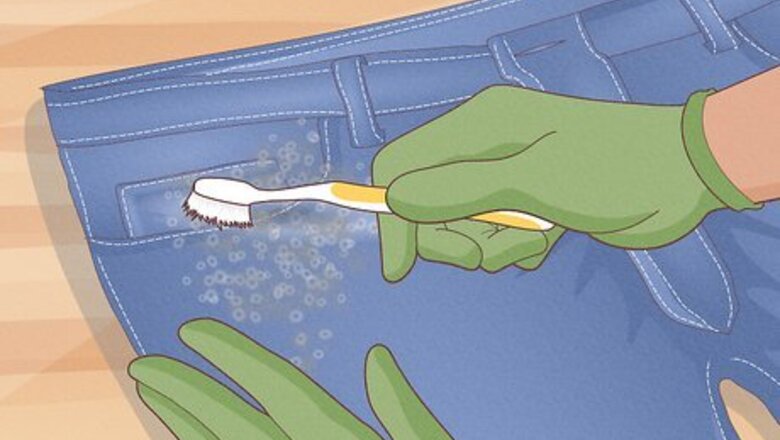
views
- Scrub the mold away with a disposable toothbrush and spray the garment with a stain remover. Then, wash the clothing with a 50/50 mix of vinegar and detergent.
- Run the clothes through a wash cycle set to "hot." Add 1 cup (237 mL) of bleach to the load, then rinse and dry the laundry as usual.
- Dissolve 1/2 cup (118 mL) of Borax in hot water. Place the clothes in the washing machine, and run a "hot" cycle with the Borax mixture.
Removing Mold with Vinegar & Detergent

Scrub off the mold using a toothbrush. Using an old toothbrush, scrub any areas on your garment with mold spots. Gently scrubbing your garment with a toothbrush will remove the top layer of mold and prepare it for spot treatment. If the garment is wet, pretreat it by letting it sit in the sun until it dries. The sun’s UV rays will help to kill off mold and mildew. Wear a KN95 mask, eye protection, and/or gloves to protect your eyes and lungs from mold spores and discard the toothbrush after scrubbing the fabric. Work in a well-ventilated area or outdoors. Not only are mold spores dangerous to inhale, but they can also travel through the air in your house and settle onto furniture, clothing, and more.
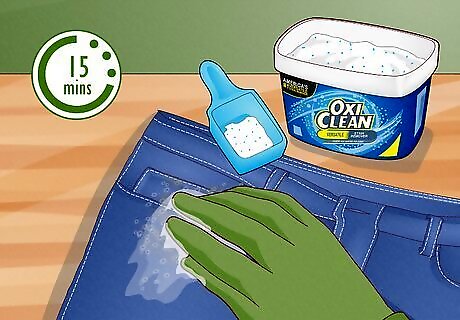
Apply stain remover to the mold spot and let it sit for 15 minutes. Once you’ve scrubbed off as much of the mold as possible, liberally apply a commercial stain remover such as Shout or Oxyclean to the moldy portion of the clothing. Most commercial stain removers typically take about 15 minutes to soak into the fabric, so wait at least 15 minutes for the stain remover to jump into action before washing the garment. Spraying the stain with a 1:4 mix of 3% hydrogen peroxide and water or rubbing the mold spot with a dry bar of Fels-Naptha soap are other effective mold-busting alternatives to using a commercial stain remover.
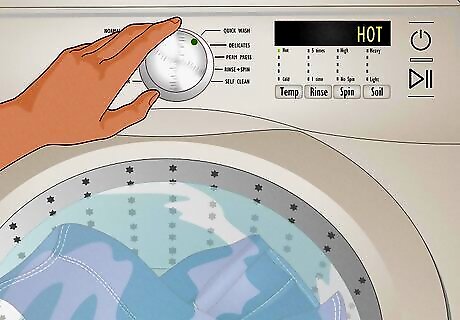
Wash the item by itself in hot water. Run your washing machine on a “large” or “extra-large” load size, and set the water temperature to “hot.” Be sure to wash the garment on its own to avoid transferring mold spores to other clothing in the washer. If your washing machine estimates what load size is necessary based on the amount of fabric in the machine, throw in a few old rags or towels for weight.
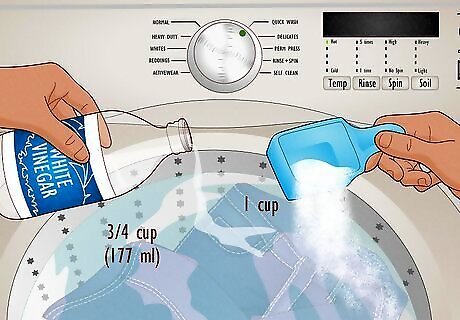
Add ¾ cup (177 mL) of white vinegar and a capful of detergent to the wash. Once the laundry machine has filled with hot water, pour ¾ cup (177 mL) of white vinegar into your washer, followed by a capful of your favorite laundry detergent (or as directed). White vinegar's acidity will help eradicate mold spores and smells from the fabric. White vinegar is safe for all clothing except darker-colored fabrics, as they may fade. Add an optional ½ tablespoon (7.4 ml) of baking soda to your laundry load to help deodorize particularly smelly clothing. EXPERT TIP Susan Stocker Susan Stocker Green Cleaning Expert Susan Stocker runs and owns Susan’s Green Cleaning, the #1 Green Cleaning Company in Seattle. She is well known in the region for outstanding customer service protocols — winning the 2017 Better Business Torch Award for Ethics & Integrity —and her energetic support of green cleaning practices. Susan Stocker Susan Stocker Green Cleaning Expert Our Expert Agrees: Washing your clothes in hot water and vinegar will kill about 80% of mold spores and help with the unpleasant moldy smell. Pour the vinegar and detergent directly into the wash. Then, fill the machine with hot water, add in your clothes, and finish the cycle. Rewash the clothes with non-chlorine bleach if any mold remains.
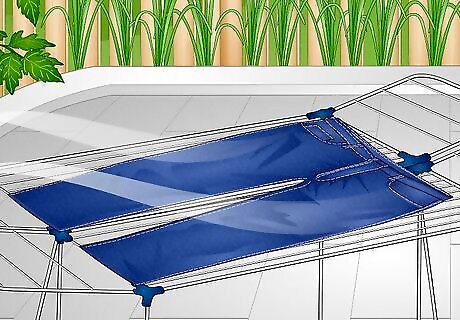
Air-dry the clothing. Let your garment air-dry on a flat surface, like on top of your dryer, or hang it on a drying rack. If it’s a nice day, dry the item of clothing outdoors, in full sunlight. The heat from the sun will help kill off and remove whatever mold may remain on your clothing. You won’t be able to tell if the mold has been completely removed from the clothing until after it’s dried and the fabric has returned to its natural color. If you still see signs of mold, it may be time to use a stronger treatment, such as bleach, or get rid of the garment entirely. Avoid using the dryer. Putting any fabric with mold issues into the dryer risks contaminating the dryer with mold spores.
Removing Mold with Bleach
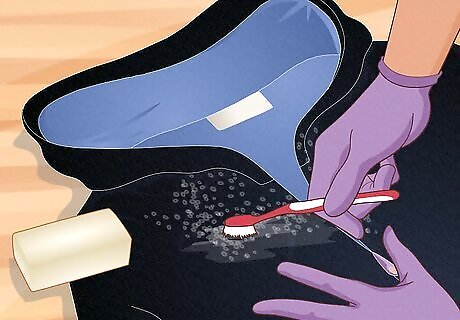
Scrub the mold with a toothbrush and apply laundry soap to the stains. While you wait for your washing machine to fill up, use a clean, dry toothbrush to gently remove the top layer of moldy dust from your garment. Then, rub a dry bar of Fels-Naptha soap onto any mold spots to pretreat the garment before going into the wash. Work in a well-ventilated area and wear a KN95 mask, gloves, and eyewear to protect yourself from mold spores. Dispose of the toothbrush once you’re done using it.
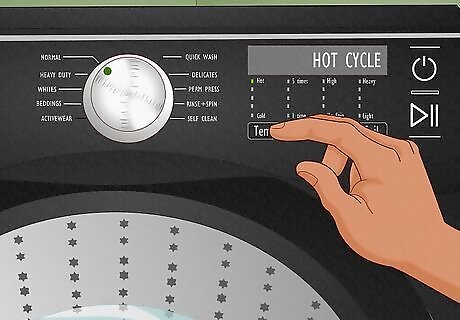
Begin a hot water cycle while your washing machine is empty. Hot water kills and removes mold, whereas warm or cold water is ineffective. Be sure to wait for your machine to fill up with hot water before adding in your garments.
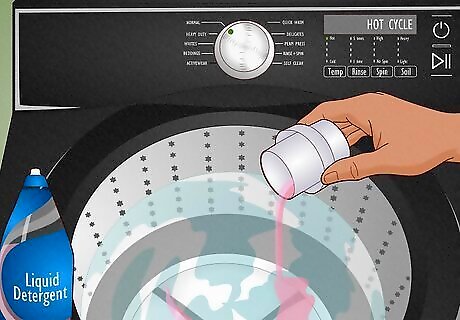
Add a capful of laundry detergent once the machine is mostly full. The detergent will help to loosen and clean mold particles from your clothing once you throw it in the wash.
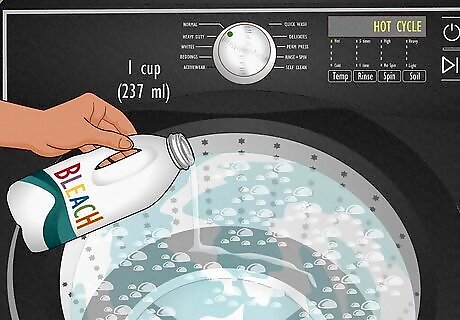
Pour 1 cup (237 mL) of bleach into the washer. Once the detergent has started to foam, add 1 cup (237 mL) of bleach to the water. Alternatively, if your laundry machine has a receptacle specifically labeled “bleach,” pour the bleach in that opening instead. The bleach will effectively kill the mold particles on your fabric or garment—see ya, spores! Only use bleach on white clothing, as it will fade or remove the color from dyed fabrics. Manufacturer’s recommendations can vary concerning how much bleach to add to a load of laundry. If your bleach recommends using more or less than 1 cup, follow the instructions on the packaging.
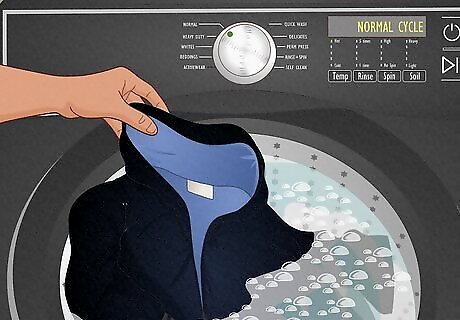
Add your garment to the water and run a wash cycle as normal. After adding a capful of detergent and 1 cup (237 mL) of bleach, let the machine finish filling with hot water, and toss in your moldy clothing. Once the load has finished, the bleach will have removed the mold from your clothing. If the mold is still on your clothing, wash the garment following the same steps again. Air dry your garments in the sun by lying them on a flat, clean surface, like on a towel in your driveway or backyard.
Getting Mold out with Borax
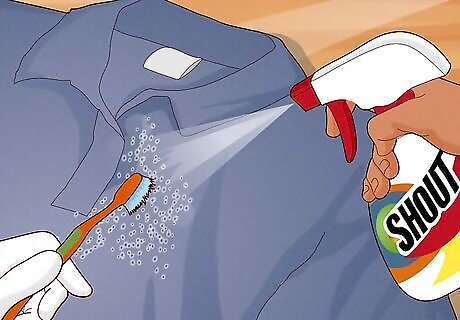
Scrub the mold with a toothbrush and apply a stain remover. Using a clean, dry toothbrush, gently scrub the mold spot(s) on your garment until you’ve removed the dusty-looking top layer. Then, apply a few spritzes of commercial stain remover like Shout, and let it sit for 15 minutes. Be sure to work in a well-ventilated area and wear a KN95 mask, gloves, and glasses to protect yourself from mold spores. Dispose of the toothbrush once you’re done working with it.
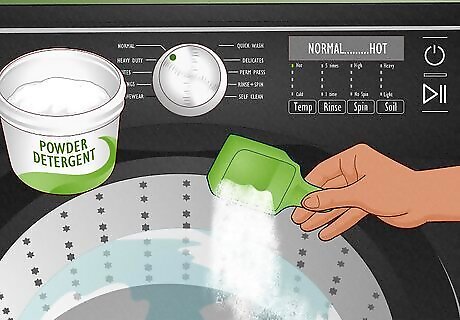
Start a hot water cycle on your washer and add a capful of detergent. Start by adding a capful of your favorite detergent into the hot water. Hot water and detergent help to loosen and kill the mold particles on your clothing, as well as remove any residual stains. Wait to add your moldy garment until after you've incorporated Borax into the water. Avoid washing other, non-moldy clothes at the same time.
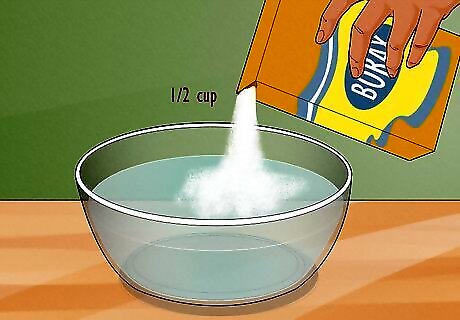
Dissolve 1/2 cup of Borax in a bowl of hot water while your washer fills. Select a large pot or mixing bowl and fill it with hot water. Then, pour in ½ cup (64 g) of Borax. Use a spoon or other utensil to stir the Borax until it’s completely dissolved. If you have a front-loading washing machine, add ½ cup (64 g) of dry Borax powder to the washer drum before letting it fill with water.

Add the Borax solution to your load of laundry once it's filled with water. Once the Borax has completely dissolved in the bowl of hot water, slowly pour the solution into your washing machine.

Add your clothing to the wash and run the load as normal. Once you’ve poured your Borax solution into a washing machine tub full of hot water, it’s time to toss in your moldy clothing. The final rinse cycle on your laundry machine, combined with the cleaning power of Borax, should effectively remove all of the mold from your garment. Hurray! If mold still remains on your clothing, consider rewashing the item using an alternate method, such as vinegar or bleach, or having it professionally laundered at the dry cleaners. Let the clothes air dry after they’ve been laundered.




















Comments
0 comment